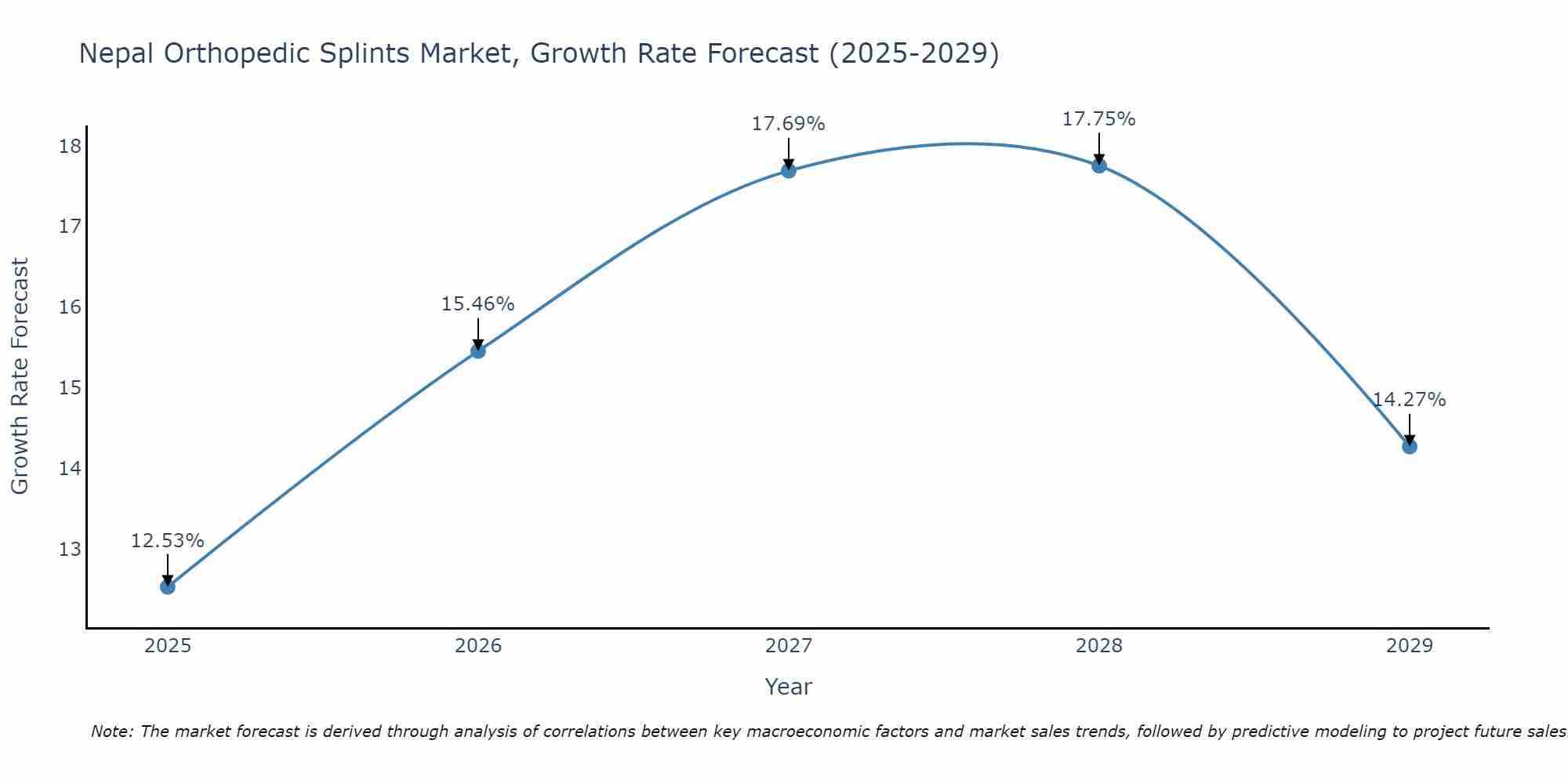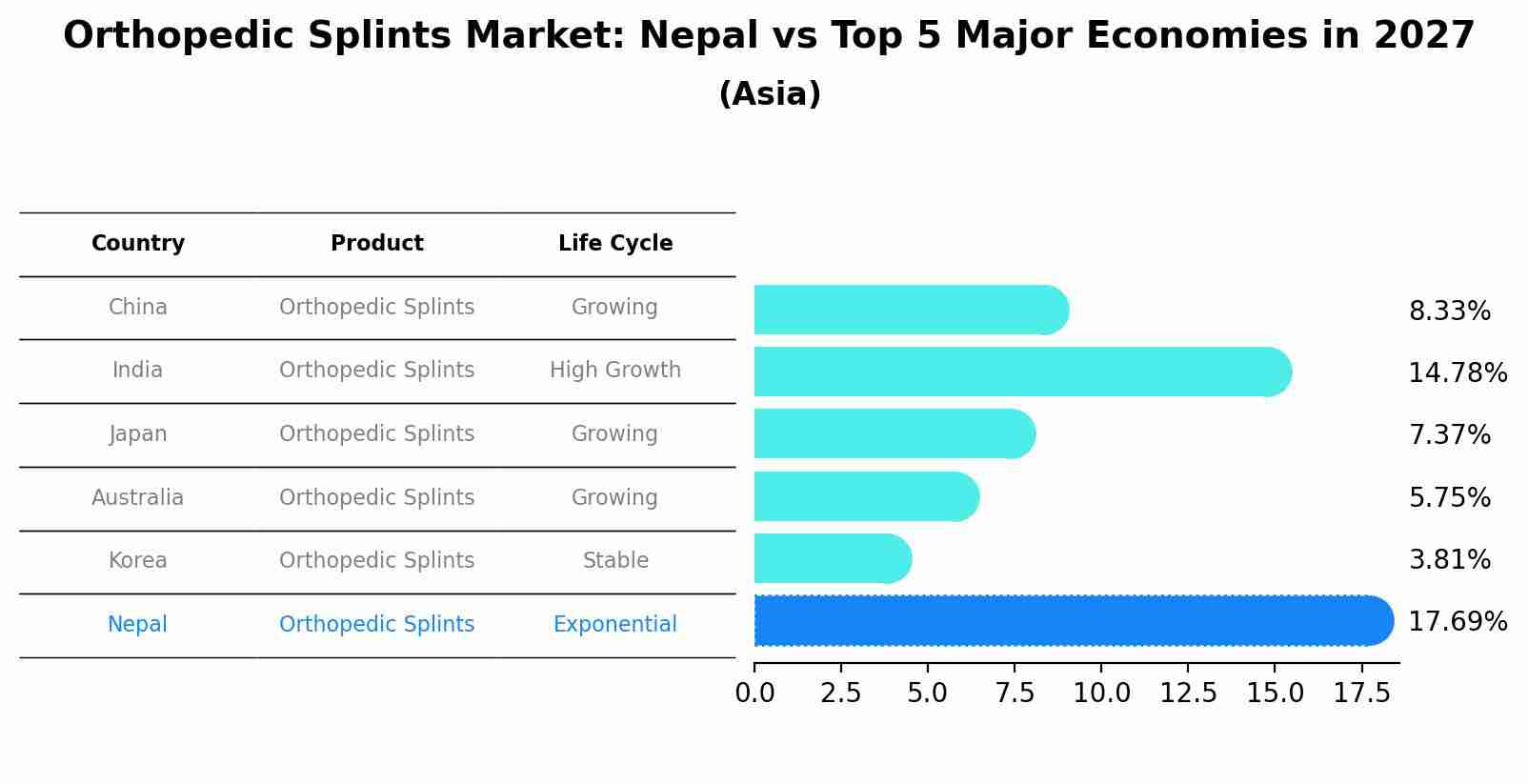Nepal Orthopedic Splints Market (2025-2031) Outlook | Value, Revenue, Analysis, Size, Companies, Forecast, Industry, Growth, Share & Trends
| Product Code: ETC336516 | Publication Date: Aug 2022 | Updated Date: Aug 2025 | Product Type: Market Research Report | |
| Publisher: 6Wresearch | Author: Dhaval Chaurasia | No. of Pages: 75 | No. of Figures: 35 | No. of Tables: 20 |
Nepal Orthopedic Splints Market Size Growth Rate
The Nepal Orthopedic Splints Market is projected to witness mixed growth rate patterns during 2025 to 2029. The growth rate begins at 12.53% in 2025, climbs to a high of 17.75% in 2028, and moderates to 14.27% by 2029.

Orthopedic Splints Market: Nepal vs Top 5 Major Economies in 2027 (Asia)
In the Asia region, the Orthopedic Splints market in Nepal is projected to expand at a exponential growth rate of 17.69% by 2027. The largest economy is China, followed by India, Japan, Australia and South Korea.

Nepal Orthopedic Splints Market Synopsis
The Nepal Orthopedic Splints Market is witnessing steady growth driven by an increasing number of orthopedic injuries and the rising prevalence of musculoskeletal disorders. Orthopedic splints are widely used in the country to provide support and immobilization for fractures, sprains, and other orthopedic conditions. The market is characterized by a diverse range of products including prefabricated splints, custom-made splints, and traction splints. Key market players in Nepal are focusing on product innovation, quality improvement, and expanding distribution networks to cater to the growing demand. Government initiatives to improve healthcare infrastructure and increase access to orthopedic care are also contributing to market growth. Overall, the Nepal Orthopedic Splints Market is expected to continue its positive trajectory in the coming years.
Nepal Orthopedic Splints Market Trends
The Nepal Orthopedic Splints Market is currently witnessing a growing demand for innovative and technologically advanced products that offer better comfort, flexibility, and support to patients. There is a notable trend towards the development of lightweight and breathable splints made from materials such as fiberglass and thermoplastics, which enhance patient compliance and overall effectiveness of treatment. Additionally, there is an increasing focus on the customization of splints to provide a personalized fit for individual patients, driving the adoption of 3D printing technology in the manufacturing process. With a rising incidence of orthopedic injuries and disorders in Nepal, healthcare providers are also placing greater emphasis on expanding their product portfolios to cater to a wider range of orthopedic conditions, further fueling market growth.
Nepal Orthopedic Splints Market Challenges
In the Nepal Orthopedic Splints Market, several challenges are faced, including limited awareness among the general population about the benefits and availability of orthopedic splints, especially in rural areas. This lack of awareness leads to underutilization of these products, hindering market growth. Additionally, the market faces challenges related to the availability of high-quality and affordable orthopedic splints, as well as inadequate healthcare infrastructure in certain regions. Supply chain inefficiencies and a shortage of skilled healthcare professionals trained in orthopedic splinting techniques further contribute to the challenges faced by the market. Overcoming these obstacles requires targeted educational campaigns, improved distribution networks, and training programs for healthcare providers to enhance the adoption of orthopedic splints and improve patient outcomes.
Nepal Orthopedic Splints Market Investment Opportunities
The Nepal Orthopedic Splints Market presents promising investment opportunities due to the increasing incidence of orthopedic injuries and the growing awareness about the benefits of splinting in the country. With an aging population and rising participation in sports activities, the demand for orthopedic splints is expected to rise. Investors can explore opportunities in manufacturing and distributing orthopedic splints, as well as investing in research and development to introduce innovative products tailored to the specific needs of the Nepalese population. Additionally, partnerships with healthcare facilities and orthopedic clinics can help in expanding market reach and establishing a strong presence in the growing orthopedic splints market in Nepal.
Jordan Agar Market Government Policies
The government of Nepal has implemented various policies and regulations related to the Orthopedic Splints Market to ensure product quality, safety, and accessibility. The Department of Drug Administration (DDA) regulates and monitors the production, distribution, and sale of orthopedic splints to ensure they meet quality standards and are safe for use. Importers and manufacturers need to obtain licenses from the DDA to operate in the market. Additionally, the government provides subsidies and incentives for domestic production of orthopedic splints to promote local manufacturing and reduce dependency on imports. These policies aim to enhance the competitiveness of the domestic market, improve access to affordable orthopedic splints for patients, and ensure compliance with quality standards.
Nepal Orthopedic Splints Market Future Outlook
The Nepal Orthopedic Splints market is expected to witness steady growth in the coming years due to several factors such as an increasing prevalence of orthopedic injuries and disorders, rising geriatric population, and advancements in healthcare infrastructure. The market is likely to be driven by a growing awareness about the benefits of orthopedic splints in aiding the recovery process and reducing pain. Additionally, the adoption of innovative materials and technologies for splint manufacturing is expected to propel market growth. However, factors such as limited accessibility to healthcare services in rural areas and high cost associated with orthopedic splints may pose challenges to market expansion. Overall, the Nepal Orthopedic Splints market is projected to show promising growth opportunities in the foreseeable future.
Key Highlights of the Report:
- Nepal Orthopedic Splints Market Outlook
- Market Size of Nepal Orthopedic Splints Market, 2024
- Forecast of Nepal Orthopedic Splints Market, 2031
- Historical Data and Forecast of Nepal Orthopedic Splints Revenues & Volume for the Period 2021 - 2031
- Nepal Orthopedic Splints Market Trend Evolution
- Nepal Orthopedic Splints Market Drivers and Challenges
- Nepal Orthopedic Splints Price Trends
- Nepal Orthopedic Splints Porter's Five Forces
- Nepal Orthopedic Splints Industry Life Cycle
- Historical Data and Forecast of Nepal Orthopedic Splints Market Revenues & Volume By Application for the Period 2021 - 2031
- Historical Data and Forecast of Nepal Orthopedic Splints Market Revenues & Volume By Lower extremity for the Period 2021 - 2031
- Historical Data and Forecast of Nepal Orthopedic Splints Market Revenues & Volume By Upper extremity for the Period 2021 - 2031
- Nepal Orthopedic Splints Import Export Trade Statistics
- Market Opportunity Assessment By Application
- Nepal Orthopedic Splints Top Companies Market Share
- Nepal Orthopedic Splints Competitive Benchmarking By Technical and Operational Parameters
- Nepal Orthopedic Splints Company Profiles
- Nepal Orthopedic Splints Key Strategic Recommendations
Frequently Asked Questions About the Market Study (FAQs):
1 Executive Summary |
2 Introduction |
2.1 Key Highlights of the Report |
2.2 Report Description |
2.3 Market Scope & Segmentation |
2.4 Research Methodology |
2.5 Assumptions |
3 Nepal Orthopedic Splints Market Overview |
3.1 Nepal Country Macro Economic Indicators |
3.2 Nepal Orthopedic Splints Market Revenues & Volume, 2021 & 2031F |
3.3 Nepal Orthopedic Splints Market - Industry Life Cycle |
3.4 Nepal Orthopedic Splints Market - Porter's Five Forces |
3.5 Nepal Orthopedic Splints Market Revenues & Volume Share, By Application, 2021 & 2031F |
4 Nepal Orthopedic Splints Market Dynamics |
4.1 Impact Analysis |
4.2 Market Drivers |
4.2.1 Increasing incidence of orthopedic injuries and disorders in Nepal |
4.2.2 Growing awareness about the benefits of orthopedic splints in the country |
4.2.3 Improving healthcare infrastructure and access to orthopedic care services |
4.3 Market Restraints |
4.3.1 Limited availability of advanced orthopedic splints technology in Nepal |
4.3.2 High cost associated with orthopedic splints hindering adoption rates |
5 Nepal Orthopedic Splints Market Trends |
6 Nepal Orthopedic Splints Market, By Types |
6.1 Nepal Orthopedic Splints Market, By Application |
6.1.1 Overview and Analysis |
6.1.2 Nepal Orthopedic Splints Market Revenues & Volume, By Application, 2021 - 2031F |
6.1.3 Nepal Orthopedic Splints Market Revenues & Volume, By Lower extremity, 2021 - 2031F |
6.1.4 Nepal Orthopedic Splints Market Revenues & Volume, By Upper extremity, 2021 - 2031F |
7 Nepal Orthopedic Splints Market Import-Export Trade Statistics |
7.1 Nepal Orthopedic Splints Market Export to Major Countries |
7.2 Nepal Orthopedic Splints Market Imports from Major Countries |
8 Nepal Orthopedic Splints Market Key Performance Indicators |
8.1 Average waiting time for orthopedic splints in hospitals and clinics |
8.2 Number of orthopedic clinics offering splinting services in Nepal |
8.3 Patient satisfaction rates with orthopedic splints treatment |
9 Nepal Orthopedic Splints Market - Opportunity Assessment |
9.1 Nepal Orthopedic Splints Market Opportunity Assessment, By Application, 2021 & 2031F |
10 Nepal Orthopedic Splints Market - Competitive Landscape |
10.1 Nepal Orthopedic Splints Market Revenue Share, By Companies, 2024 |
10.2 Nepal Orthopedic Splints Market Competitive Benchmarking, By Operating and Technical Parameters |
11 Company Profiles |
12 Recommendations |
13 Disclaimer |
- Single User License$ 1,995
- Department License$ 2,400
- Site License$ 3,120
- Global License$ 3,795
Search
Thought Leadership and Analyst Meet
Our Clients
Related Reports
- Canada Oil and Gas Market (2026-2032) | Share, Segmentation, Value, Industry, Trends, Forecast, Analysis, Size & Revenue, Growth, Competitive Landscape, Outlook, Companies
- Germany Breakfast Food Market (2026-2032) | Industry, Share, Growth, Size, Companies, Value, Analysis, Revenue, Trends, Forecast & Outlook
- Australia Briquette Market (2025-2031) | Growth, Size, Revenue, Forecast, Analysis, Trends, Value, Share, Industry & Companies
- Vietnam System Integrator Market (2025-2031) | Size, Companies, Analysis, Industry, Value, Forecast, Growth, Trends, Revenue & Share
- ASEAN and Thailand Brain Health Supplements Market (2025-2031) | Strategy, Consumer Insights, Analysis, Investment Trends, Opportunities, Growth, Size, Share, Industry, Revenue, Segments, Value, Segmentation, Supply, Forecast, Restraints, Outlook, Competition, Drivers, Trends, Demand, Pricing Analysis, Competitive, Strategic Insights, Companies, Challenges
- ASEAN Bearings Market (2025-2031) | Strategy, Consumer Insights, Analysis, Investment Trends, Opportunities, Growth, Size, Share, Industry, Revenue, Segments, Value, Segmentation, Supply, Forecast, Restraints, Outlook, Competition, Drivers, Trends, Demand, Pricing Analysis, Competitive, Strategic Insights, Companies, Challenges
- Europe Flooring Market (2025-2031) | Outlook, Share, Industry, Trends, Forecast, Companies, Revenue, Size, Analysis, Growth & Value
- Saudi Arabia Manlift Market (2025-2031) | Outlook, Size, Growth, Trends, Companies, Industry, Revenue, Value, Share, Forecast & Analysis
- Uganda Excavator, Crane, and Wheel Loaders Market (2025-2031) | Strategy, Consumer Insights, Analysis, Investment Trends, Opportunities, Growth, Size, Share, Industry, Revenue, Segments, Value, Segmentation, Supply, Forecast, Restraints, Outlook, Competition, Drivers, Trends, Demand, Pricing Analysis, Competitive, Strategic Insights, Companies, Challenges
- Rwanda Excavator, Crane, and Wheel Loaders Market (2025-2031) | Strategy, Consumer Insights, Analysis, Investment Trends, Opportunities, Growth, Size, Share, Industry, Revenue, Segments, Value, Segmentation, Supply, Forecast, Restraints, Outlook, Competition, Drivers, Trends, Demand, Pricing Analysis, Competitive, Strategic Insights, Companies, Challenges
Industry Events and Analyst Meet
Whitepaper
- Middle East & Africa Commercial Security Market Click here to view more.
- Middle East & Africa Fire Safety Systems & Equipment Market Click here to view more.
- GCC Drone Market Click here to view more.
- Middle East Lighting Fixture Market Click here to view more.
- GCC Physical & Perimeter Security Market Click here to view more.
6WResearch In News
- Doha a strategic location for EV manufacturing hub: IPA Qatar
- Demand for luxury TVs surging in the GCC, says Samsung
- Empowering Growth: The Thriving Journey of Bangladesh’s Cable Industry
- Demand for luxury TVs surging in the GCC, says Samsung
- Video call with a traditional healer? Once unthinkable, it’s now common in South Africa
- Intelligent Buildings To Smooth GCC’s Path To Net Zero


















